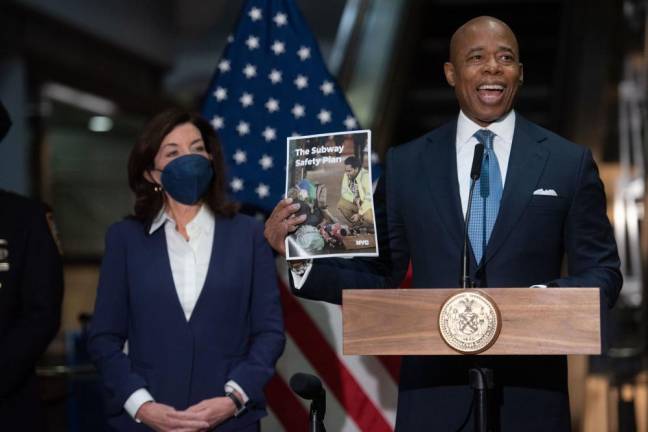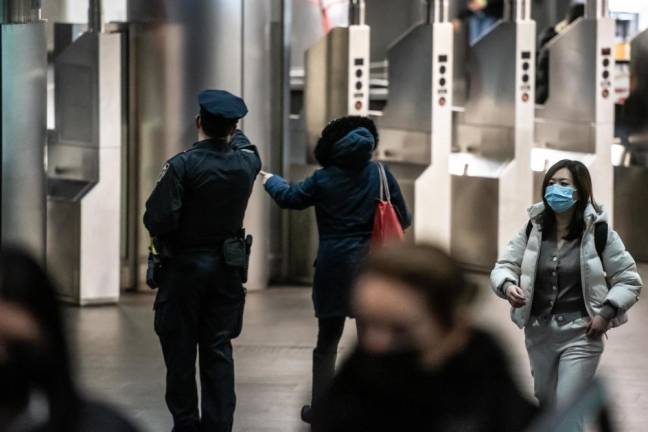A City on Edge
The longing for normality and the anxiety over safety vie in New Yorkers each day


The West Sider was in a hurry to get home from her office in Times Square. “My thing is to get the heck out of the subway station and get on the train,” she said.
But on this day the uptown express was 9 minutes away.
So she scanned the platform, contemplating the local, which she rarely takes.
A fashionable Asian woman caught her eye. She had secured a spot well back from the edge, strategically centered between the express and local.
“She was very carefully standing in the middle of the platform,” the West Sider recalled.
“It reminded me that I had promised myself that’s what I would do. I’ve been trying to change my habit and not stand at the edge of the platform. So I intentionally stood back and stood next to her.”
The West Sider started to take out her phone.
“I noticed she wasn’t on her phone. I promised myself I wouldn’t stare at my phone on the subway. There were all these habits I need to break for safety.”
With no electronics to distract either of them, the West Sider turned to the other woman. “I said, ‘are we nervous?’” She nodded, yes. Then, Just Like That, the fashionable New Yorker said to the West Sider, “I really like your shoes.”
The longing for normality and the anxiety over safety vie in each of us each day now in the battered but still Great City. Every time we think the worst is behind us something new jars our sense of security. The surge of Omicron. The shoving death of Michelle Alyssa Go. Even Vladimir Putin narrating his invasion of Ukraine with the not very subtle reminder that he presides over one of the greatest nuclear powers, as if the Cuban Missile crisis was not sixty years ago this fall.
“I’m wondering if I should be training my kids, all of whom are adults, on duck and cover,” said Barbara A. Blair, President of the Garment District Alliance.
Blair offered this bit of dark humor to a reporter who called not to reminisce about the insecurity New Yorkers felt during the Cold War, but rather the sense of insecurity now in what she delicately called “this special moment we are living through.”
Surge of Disorder
Few people have a better vantage point on New York’s struggle. The Garment District is truly the crossroads of the crossroads of the world, flanked on north, south and west by three of the city’s transportation hubs – the Times Square subways, the intersection of subway, commuter and intercity lines at Moynihan station and the Port Authority Bus Terminal.
The surge of disorder that accompanied year two of the pandemic seems nowhere more disturbing than in the close confines of the city’s transit system and its use as a shelter for the homeless.
“The subways are not as bad as people say, but we have a real problem in this city with people who can’t take care of themselves,” said Blair, who uses the subways every day to get from her office on 38th Street to her home in Brooklyn. “The point is you can’t have people with needles hanging out of their arms. Passed out in the subways. Passed out in lobbies of buildings.”
Or, of course, shoving riders onto the tracks, stabbing them or hitting them with hammers and rods.
Mayor Eric Adams has made it clear that the city’s overall recovery, which has been lagging the national recovery, runs through those subways. Ridership has improved since the depths of the pandemic, but is still only a bit better than half of what it was before the pandemic.
It is hard to untangle how much of this is riders who just don’t want to be back at their offices (where usage is still only a third of pre-pandemic levels), and how much is riders fearful of using the subways to get to their offices.
But city officials recognize they have to address the fear – and the disorder that prompts it – before employers can even begin to adapt to whatever the new normal of office work will be in New York.
Subway Safety Plan
The mayor has sent 1000 more cops into the subways, and last week announced his subway safety plan for teams of cops and social service workers to find and remove the 350 people the MTA estimates have been living on cars, in stations and in the hidden nooks of the system.
“It is cruel and inhumane to allow unhoused people to live on the subway, and unfair to paying passengers and transit workers who deserve a clean, orderly, and safe environment,” said Adams. “The days of turning a blind eye to this growing problem are over.”
The mayor’s message is an important pushback to the idea, prominent for awhile, that while crime was up it was still far below the bad old days of the late twentieth century in New York, when fires burned and Son of Sam stalked New York by night.
“You can say crime was way worse in the ‘80s and ‘90s and what I would say is, ‘I don’t care’,” said Blair. “My kids are in their thirties. They’re living in this moment in time. And in this moment in time things have gotten precipitously worse, and that’s their lived experience. Me telling you how bad things were back then does not ameliorate what you’re seeing here and now. This is as bad as most young people have ever seen, and by young I mean 40 and under.”
“Something Was Wrong”
Illustrations of disorder seem to come faster than New Yorkers can absorb them.
“This morning I was nearing home from my walk and witnessed 2 large men racing out of Marshall’s on 78th and Broadway at around 9:45,” Elizabeth Lee reported Saturday on the social app Nextdoor. “These men had trash bags FULL of goods.”
“They ran out at the same time I walked by and I knew immediately something was wrong. I looked into the store and saw two employees with deer in headlights looks on their faces. They were scrambling to make calls and pointing at the men clueless of how to react. The men raced to the uptown subway station on 79th and never looked back aside from to laugh at one another as if what they’d just done was simply comical.
“All I can think (especially as a parent): why is this happening? It’s clear store employees do not know how to confront these acts. This is not the New York I know and this is not what should be happening in this neighborhood. It must be stopped before only worse happens ...”
The pressing issue, Blair and others note, is whether the Mayor’s plans are adequate. “The plan is not a crime-fighting plan; it is a homeless-control plan,” wrote former MTA transit police captain Dorothy Moses Schulz. The plan seemed “unfinished” to Schulz and “doesn’t detail any costs, nor does it indicate when some or all of these team members will be hired or reassigned from current activities.”
Blair worried that removing people from the subways, as necessary as that is, would do little good unless the city and state properly funded housing and services for the mentally ill, addicted and homeless, a sentiment echoed by one man as he was rousted from his shelter in the subway.
“They just kept telling me to ‘Get out. Get out. Get out. Go outside’,” John Timpa said to WABC Eyewitness News. “Yeah, go outside. Oh, yeah. I told them I got nowhere to go. He said, there were stabbings with people and that’s why they’re getting on me. But I’m not the one that did it.”
A short time later Timpa got right back on the subway, WABC reported.
“You can say crime was way worse in the ‘80s and ‘90s and what I would say is, ‘I don’t care.’ My kids are in their thirties. They’re living in this moment in time. And in this moment in time things have gotten precipitously worse, and that’s their lived experience.” Barbara A. Blair, President of the Garment District Alliance